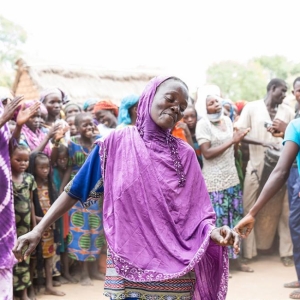Indicators in this domain assess the extent to which migrants have the same status as citizens in terms of access to basic social services such as health, education, and social security. It also describes the rights of migrants to family reunification, to work, and to residency and citizenship. The ratification of the main international conventions is also included within this domain.
Indicators in this category look at the extent to which migrants have access to certain social services such as health, education and social security. They also examine measures to ensure integration and access to work.
Indicators in this domain assess countries’ institutional, legal, and regulatory frameworks related to migration policies. Domain 2 also reviews the existence of national migration strategies that are in-line with development, as well as institutional transparency and coherence in relation to migration management. This domain also investigates the extent to which governments collect and use migration data.
Indicators in this category assess the institutional frameworks of cities for migration. This area also examines the existence of migration strategies consistent with development objectives, as well as institutional transparency and coherence in migration management.
This domain focuses on countries’ efforts to cooperate on migration-related issues with other states and with relevant non-governmental actors, including civil society organizations and the private sector. Cooperation can lead to improvements in governance by aligning and raising standards, increasing dialogue and providing structures to overcome challenges.
Indicators in this category focus on cities’ efforts to cooperate on migration issues with the national government as well as other cities and relevant non-governmental actors, including civil society organizations and the private sector.
This domain includes indicators on countries’ policies for managing the socioeconomic well-being of migrants, through aspects such as the recognition of migrants’ educational and professional qualifications, provisions regulating student migration and the existence of bilateral labour agreements between countries. Indicators equally focus on policies and strategies related to diaspora engagement and migrant remittances.
Indicators in this category assess cities’ initiatives in terms of international student mobility, access to the labour market and decent working conditions for migrant workers. Aspects related to diaspora engagement and migrant remittances are also included in this domain.
This domain studies the type and level of preparedness of countries when they are faced with mobility dimensions of crises, linked to either disasters, the environment and/or conflict. The questions are used to identify the processes in place for nationals and non-nationals both during and after disasters, including whether humanitarian assistance is equally available to migrants as it is to citizens.
Indicators in this category examine the type and level of readiness of cities to deal with aspects of mobility crises. The questions focus on the processes in place for citizens and non-citizens both during and after disasters, especially if humanitarian assistance is available for migrants and citizens.
This domain analyses countries’ approach to migration management in terms of border control and enforcement policies, admission criteria for migrants, preparedness and resilience in the case of significant and unexpected migration flows, as well as the fight against trafficking in human beings and smuggling of migrants. It also assesses efforts and incentives to help integrate returning citizens.
Indicators in this category look at the cities’ approaches to migrant safety as well as return and reintegration policies and the fight against trafficking in persons.
This country Profile describes examples of well-developed areas of Canada’s migration governance structures and areas with potential for further development, as evaluated through the six domains of the Migration Governance Indicators (MGI). These address migrants’ rights, a “whole-of-government” approach, partnerships, socioeconomic well-being of migrants, the mobility dimensions of crises, and safe and orderly migration.
Click the icons on the wheel to explore the key findings.
The Migration Governance Indicators (MGI) initiative is a policy-benchmarking programme led by the International Organization for Migration (IOM) and implemented with research and analysis from the Economist Intelligence Unit. Funding is provided by IOM Member States.
Migration Governance: examples of well-developed areas
- Canada offers a broad range of permanent and temporary pathways for work, study and family reunification as well as humanitarian pathways (resettlement and asylum programmes).
- Immigrants with permanent residence visas, including those who have come to Canada as resettled refugees, have the same access to the labour market and social security benefits as Canadian citizens.
- Health-care coverage for temporary residents depends on their legal status and length of stay and varies across provinces and territories.
Areas with potential for further development:
- Canada has not ratified some international conventions related to migrant rights, such as the International Convention on the Protection of the Rights of All Migrant Workers and Members of their Families.
Migration Governance: examples of well-developed areas
- Canada has established approaches to coordinate and consult with different levels of government on migration issues, such as the multilateral Forum of Ministers Responsible for Immigration.
- Canada plans the number of permanent residents to be admitted on an annual basis through the Immigration Levels Plan, which sets out targets and ranges for each immigration category.
- Immigration, Refugees and Citizenship Canada collects administrative data from applicants, such as visitors, international students, temporary foreign workers, permanent residents and citizenship applicants, which is used for evidence-based policy development.
Migration Governance: examples of well-developed areas
- Canada engages regularly with Mexico through the High-level Dialogue on Mobility, a forum to exchange information and collaborate on issues of mutual interest and importance related to migration.
- Canada has reciprocal bilateral youth mobility arrangements with 35 countries and territories, to allow people between the ages of 18 and 35 to travel, reside and work in each other’s country.
- Government agencies formally engage with civil society through the Civil Society Partnerships Policy for International Assistance to gain insights from their experience on the ground to inform migration policies and programmes.
- The National Settlement and Integration Council is co-chaired by the federal Government and civil society and includes members from civil society and federal, provincial and territorial governments.
- Government agencies partner with private sector actors such as Chambers of Commerce and Immigrant Employment Councils to enhance migrants’ integration in the labour market by connecting Canadian employers with migrant workers.
Migration Governance: examples of well-developed areas
- The Provincial Nominee Program allows Canadian provinces and territories (with the exception of Quebec and Nunavut, which have their own immigration programmes) to nominate individuals who wish to immigrate to Canada and are interested in settling in a particular province, to apply for permanent residence.
- Canada has three federal immigration programmes that target highly skilled migrants: the Federal Skilled Worker Program, Federal Skilled Trades Program and the Canadian Experience Class.
- Following graduation, eligible international students have the opportunity to work in Canada for up to three years through the Post-Graduation Work Permit Program.
Areas with potential for further development:
- There is no national standard for the recognition of foreign qualification.
- International students pay higher tuition fees at Canadian universities than students with Canadian citizenship or permanent resident status.
Migration Governance: examples of well-developed areas
- The Plan for the Movement of People and Goods During and Following an Emergency establishes frameworks for how to prioritize and move displaced people in times of crisis and put the preservation of life, reduction of suffering and population health first, regardless of migration status.
- Immigration, Refugees and Citizenship Canada may issue specific instructions to make exceptions to immigration procedures for migrants in the event of severe disasters in both countries of origin or in Canada and where warranted.
- Canada has launched the Global Refugee Sponsorship Initiative to share its experience and leadership in private sponsorship for resettlement with other countries.
Migration Governance: examples of well-developed areas
- Immigration, Refugees and Citizenship Canada’s website clearly outlines visa options for potential immigrants, including researching options, submitting applications and documents, and paying fees.
- The Immigration and Refugee Board of Canada is an independent tribunal established by the Parliament of Canada to resolve immigration and refugee cases efficiently and fairly.
- The Canadian Human Trafficking Hotline is a multilingual, 24/7, toll-free service that allows survivors of sex and labour trafficking to easily access the services they need.




